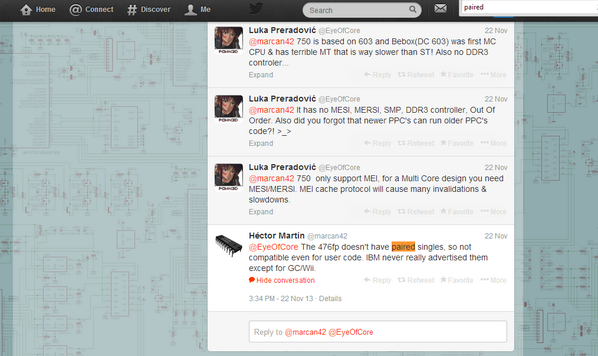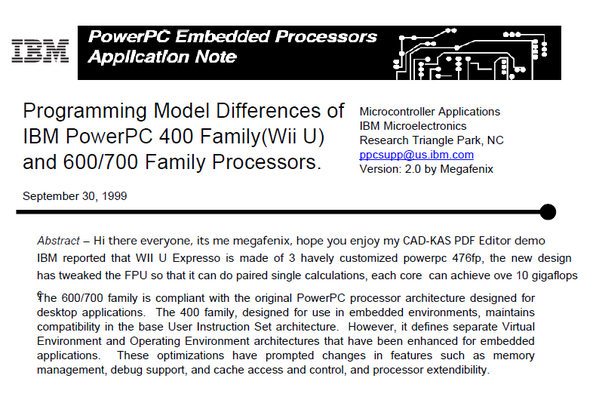Its real eye of core, and there is nothing wrong with it. The 750 was always a fantastic cpu core, and where it hit a dead end in the past, time and newer technology has now enabled it to mantain multicore coherency, and to be clocked at a more reasonable clock speed.
It doesnt have a 'real' simd unit. But its custom fpu unit has not gone without improvements. As stated in that first page of documentation. Its recieved enhancements to its floating point performance. No, that doesnt look like its going to give the same flop boon as a dedicated simd unit, but to be perfectly honest, flops have never really been the focus of a cpu, and last gen with xenon and cell are outliers, not the standard. Whatever flop performance espresso is capable of is obviously good enough for Nintendo, who have done some very, very, impressive things with the under powered broadway in this regaurd, up to having their own proprietary dmm solution working, in real time, in wii sports resort and skyward sword.
It is well matched with the gpu, and well suited to what nintendo wanted to be able to do moving forward, and looking at the intricate interactivity they acheived in titles like skyward sword, we will certainly be impressed by things the wii u will be doing that nobody entertained because they were too busy ridiculing lol 750 based.
And no, your example is not legitimate, because you are comparing the format of an application note, to the format of a users manual... When not even all user manuals and application notes all have the same exact format with their associated bretheren.
The official documentation of broadway, which I have, and Gekko, which I have as well as xenon and cell, also, all of which I have, look nothing like the format of the application note you posted.
The legitimacy of the information isnt in superficial comparisons of format, it lies within the information provided, which is rock solid information, and highly unlikely to be faux, for numerous reasons I will not bother explaining to you, as you will only invent crazier tales to discredit them, turning the developer who kindly donated the cover sheet of espresso into some kind of sociopathic omniescent mastermind in your ttempts to explain away every obstacle you encounter and how he deviously calculated every detail.
I dont see rock solid information in this

has marcan forgotten this?
http://www.ign.com/articles/2001/12/13/interview-ibm-details-gekko-part-i
"
Interview: IBM Details Gekko (Part I)
Two of the main designers behind GameCube's Gekko CPU give new insights in this IGNcube interview.
by IGN Staff
DECEMBER 12, 2001
IGNcube: Were you both involved with the design of Gekko?
IBM, Mike West:
Yes we were. I'm actually a multimedia architect. My background is graphics and multimedia, and I've been working closely with Nintendo for -- probably -- it's got to be close to four years now. And Pete, he is our lead PowerPC architect who actually worked on the detailed architecture of the Gekko chip for the changes we made, over and above the PowerPC architecture. So Pete led the [design] of the actual chip architecture and I worked with Nintendo across the system.
IGNcube: There's a sort of general conception that Gekko is just a basic PowerPC 750 and IBM didn't really modify the core that much. Is there anything you would say to dispel that conception?
IBM, Mike West:
There have been some recent articles on the web that have that view, which is a little surprising. We presented a lot of details at Hot Chips and the Embedded Processor Forum, both public domains. But, Gekko is a lot more than just a PowerPC 750 and it is an integral part of the system.
IBM, Peter Sandon:
Nintendo came to us and said, "Here's what we need for a graphics system. We need FPU (floating point) performance beyond what will be built into the graphics chip itself and we need to move data." So the main things we concentrated on where those two: moving data through the system as it's processed and a high level of floating point performance in order to do some of the things one might expect are done on the graphics chip, but in order to do more custom kind of lighting and geometry and so-forth that can't be done in some of the fixed-function graphics pipeline on the graphics processor, we enhanced our floating point performance.
IGNcube: At the Embedded Processor Forum it was said that Gekko was used for the "close-up lighting in Luigi's Mansion." What kind of assistance does Gekko provide with that and other graphics functions?
IBM, Peter Sandon:
Well it basically does the local lighting calculations. The lighting that's implemented in the graphics chip is for lights at infinity. So, if you want to get the effects that you get from so-called local lights that don't look like they're out at infinity, those calculations are done on Gekko.
IGNcube: How much flexibility does Gekko have to assist in these kinds of graphical functions? How hard does it hit the processor when you start doing something like that.
IBM, Mike West:
You have to understand what's done with the floating point unit. It is the conventional 64-bit PowerPC floating point unit, but the adaptations we made to it allow two simultaneous 32-bit calculations to occur. Basically each instruction is completed every cycle.
IBM, Peter Sandon:
Right, and I should say that it is a significant effort to implement the paired-single floating point function beyond what is there in the standard PowerPC.
"
Not saying that 750 wasnt fantastic processor, but the 476fp beats it both in power consumption and in DMIPS and maybe even at flops since IBM says that it packs more than 3 gigaflops, not to mention that it only occupies 3.7mm2 per core(of course that I have read that actual die size in multicore design could go up to 4mm2 per core) and was designed for embedded software in mind, so the Green Hills Software makes more sense for this processor
On pùrpose, I am not eyeofcore
Edited by megafenix, 03 December 2013 - 09:51 AM.





 This topic is locked
This topic is locked



























